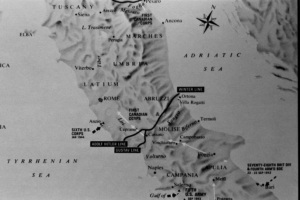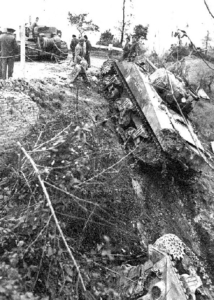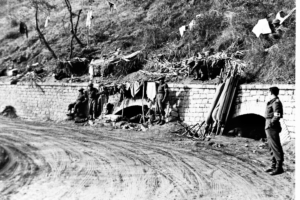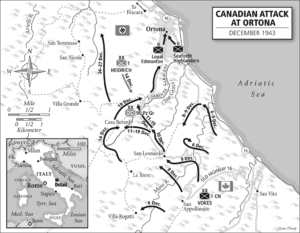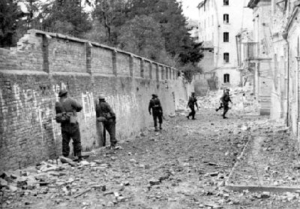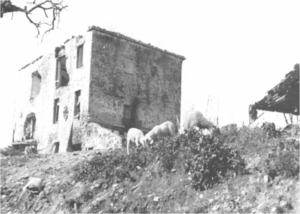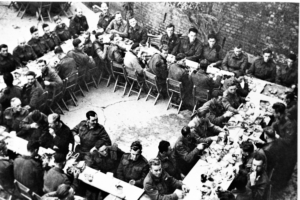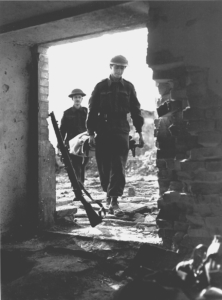Sequence of Events
During the Italian campaign the allied forces came across multiple defensive lines
created by the Germans. None of them was as deadly as the Winter Line that passed through Ortona.
-
July 1943
-
5-6 December 1943
MORO RIVER
The Germans withdrew to the next river—the Moro—and dug in for another round. On the night of 5–6 December, the 1st Canadian Infantry Division and 1st Canadian Armoured Brigade took over Eighth Army’s lead and drew the job of forcing a crossing of the Moro. In the early morning hours of 6 December, a three-pronged attack began. Only the Princess Patricia’s Canadian Light Infantry (PPCLI) made headway, winning Villa Rogatti on the left flank. When engineers were unable to erect a bridge across the Moro to enable tanks to support the PPCLI, a withdrawal was ordered. It took until 9 December for the Canadians to win a firm bridgehead. The expectation was that a quick advance around the flank of Ortona, a port and fishing town on the Adriatic Sea, would follow.
There was no expectation that the Germans would make a stand at Ortona.
5-6 December 1943
-
THE GULLY
Two days of fighting brought the Canadians to what appeared on topographical maps as nothing but a narrow, minor gap about a kilometre south of Ortona. But as the leading troops approached, they discovered the line was actually a deep, narrow gully. The Germans had dug deep holes into its southern bank that protected them from artillery fire. When the shelling stopped, the Germans dashed up to the gully’s edge to fire their machine guns on the Canadian infantry advancing up a gradual slope through tangled vineyards and olive groves. “The Gully,” as the Canadians dubbed it, proved impossible to break with the direct attacks ordered by 1st Division’s Major General Chris Vokes. Each attack by a single battalion was thrown back with heavy casualties.
Drenching rain and falling temperatures added to the misery. The battleground mirrored the muddy no man’s land between opposing sides during the First World War.
-
12 December 1943
ORTONA
Unexpectedly, the German 1st Parachute Division only withdrew as far as Ortona. Suddenly the Canadians were confronted with something for which they had no training—a street battle. The Germans had started preparing to defend Ortona on 12 December by using explosives to blow many houses apart to create piles of rubble into which they dug deep fighting positions. Mines were scattered throughout the town. By 19 December, all side streets were clogged with rubble.Two large buildings were blown down to block a street called Corso Vittorio Emanuele, at the entrance to the square facing the town hall. The municipal hall’s clock was removed from its tower and a machine gun mounted in the opening. At dawn on 21 December, German engineers most likely demolished the tower adjacent to the Cattedrale San Tomasso so that the falling structure cleaved the cathedral dome in half. As this destruction was being carried out, the Loyal Edmonton Regiment’s “D” Company was cut apart trying to fight its way into Ortona. Its 60 men were reduced to 17 in mere minutes.
Despite these losses, the company’s survivors gained a foothold on the outskirts and were soon reinforced by other companies of their battalion. The Seaforth Highlanders of Canada and tanks of the Three Rivers Regiment also came alongside.These two infantry battalions and a single tank regiment would carry the fight through the deadly labyrinth of Ortona in eight days of unrelenting battle. So intense was the street battle that war correspondents nicknamed Ortona “Little Stalingrad” because the fighting so resembled the definitive struggle in that Eastern Front city in Russia.
12 December 1943
-
14-15 December 1943
CASA BERARDI
Finally on the night of 14–15 December, the Royal 22nd Regiment’s 81 men of “C” Company, commanded by Captain Paul Triquet, managed to outflank the gully. Supported by seven Ontario Regiment tanks, this tiny force fought through fierce German resistance to win a farmhouse called Casa Berardi.
For four days, fighting raged around this small strongpoint before the Germans slunk away. For his valour, Triquet was awarded a Victoria Cross, the Commonwealth’s highest award for military bravery.
-
23 December 1943
CHRISTMAS
As the hand-to-hand struggle inside Ortona played out, two other Canadian brigades tried outflanking the town to the west. Success on this front would have forced the German paratroopers in Ortona to withdraw or be surrounded. The flanking attacks gained some initial headway before being blocked by the Germans.Christmas Day brought no relief in the fighting either in Ortona or out on its western flank. On a western ridge, the 48th Highlanders were cut off and the supporting artillery officer could only save the situation by circling the Canadians within a ring of shellfire.
Inside Ortona, meanwhile, as Germans and Canadians traded bullets and grenades, the Seaforth’s quartermaster and headquarters staff organized a sumptuous Christmas dinner to which one company at a time was brought out of the line to be fed. The men of the Edmontons, however, had no reprieve. Their rations were delivered to the fighting lines.
23 December 1943
-
27 December 1943
FALL OF ORTONA
On 27 December, the CBC’s Matthew Halton reported that “the battle has the quality of a nightmare.” But it was a nightmare soon ended. The following morning, 28 December, an Edmonton patrol discovered that the paratroopers had pulled out quietly during the night—surrendering Ortona to the Canadians. December’s fighting cost 2,339 casualties, including 502 killed — although the actual number of Canadians killed inside Ortona was never determined.
German losses were also never calculated, but two divisions had been badly mauled between the Moro River and the end of the town battle. As Ortona had not been evacuated before the fighting started, many civilians were also killed and wounded. The most authoritative estimate sets civilian deaths at 1,314. The town itself was a ruin that required years to rebuild. During the early winter months of 1944, despite its battle damage, Ortona served as a rest area for Canadian forces deployed a short distance to the north along the Arielli River
Information curtesy of the Canadian Encyclopedia: www.thecanadianencyclopedia.ca/en/article/battle-of-ortona


